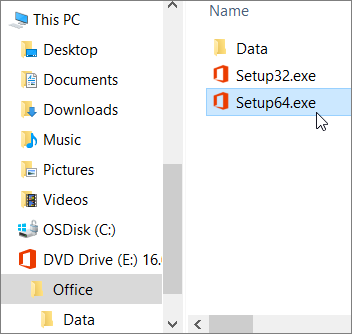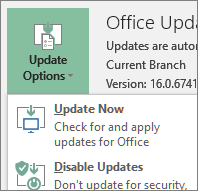Offline installer manual steps
If the Microsoft Support and Recovery Assistant didn’t help, follow the steps below that are specific to your plan. You need to be connected to the internet to download this installer file, but once that’s done, you can then install Officeoffline on a PC at your convenience.
The steps below differ if your Officeproduct is part of an Office for home or Office for business plan so you need to select the correct tab for your product.
Select your plan
Office for home
Step 1. Download the offline installer from your account portal
- To download the offline installer, go to www.office.com. If you’re not already signed in with the Microsoft account associated with your copy of Officedo that now. If you’re signed in with a different account, sign out of that and then sign in again with the correct Microsoft account.
Note: If you’re trying to install Microsoft 365 that you got through your work or school and you already signed in with your work or school account, don’t follow these instructions. Select the Office for business tab from above instead.
- Select Install Office. If you have a Microsoft 365 subscription, you’ll also need to select Install Office > on the Installs page.
- In the Download and install window, select Other options.
- Check the box Download an offline installer and select the language you want to install Officein. Select Download.
- When you’re prompted, from the bottom of your browser window, select Save (in Edge), Open (in Internet Explorer), Open when done (in Chrome), or Save File (in Firefox). The file will begin downloading on your PC.
- Once the download is complete, open File Explorer and locate a new virtual drive, for example (D:). This drive contains the Office installation files. If you don’t see the new drive, locate the image file you downloaded and double-click it. The new drive should appear in your directory.
Note: If you already have a drive labeled (D:), Office creates a virtual drive with the next available letter, which would be (E:) (as shown in the next step below).
Save the image: You can also choose to save a copy of this virtual drive to a thumb drive or disc for later use.
Step 2. Install Office
- Select the Officefolder from the virtual drive and then double-click either the Setup32.exe to install the 32-bit version of Office, or Setup64.exe to install the 64-bit version to begin the offline installation. If you’re not sure which version is right for you, see Choose the 64-bit or 32-bit version of Office.
 When you see the message, You’re all set, you can access your Office applications.
When you see the message, You’re all set, you can access your Office applications. - After your Office installation is complete, you need to activate Office. Be sure you’re connected to the Internet and then open any Office application, such as Word or Excel.
In most cases, Office is activated once you start an application and after you click Accept to agree to the License terms. If you need activation help, see Activate Office.
- After activating Office and before you start using it, make sure you have the latest update.
In any Office app, for example Word, open a new or existing document, then select File, > Account.
From the Update Options drop-down list box, select Update Now.

If you have a Microsoft 365 for business product you can use the OfficeDeployment Tool (ODT) to download and install Microsoft 365 offline. The tool is designed for enterprise environments and runs from the command line, so the steps are more complicated–but they’ll still work for installation on a single device.
You must have an Officelicense assigned to you to install and activate Office. To check if you have one, see What Microsoft 365 business product or license do I have?
Step 1 – Download and install the Office Deployment Tool
- Create a folder on your hard drive and name it ODT. For this example, we’ll create it on the c:\ drive, like so: c:\ODT.
- Download the OfficeDeployment Tool from the Microsoft Download Center. Select Save As and save it to your downloads folder.
- In your downloads folder, double-click the Office Deployment Tool exe file to install it.
- If you see the User Account Control prompt that says, Do you want to allow this app to make changes to your device?, click Yes.
- Accept the Microsoft Software License Terms, and then click Continue.
- In the Browse for Folder dialog, select the ODT folder you created in earlier, and then click OK.
Step 2 – Download and install Office
The drop-down list below contains detailed steps that show how to download and install the 32-bit or 64-bit version of Microsoft 365 Apps for enterprise or Microsoft 365 Apps for business.
If you have a Microsoft 365 Apps for business or Microsoft 365 Business Standard plan, you need to download the Microsoft 365 Apps for business version. For all other plans, download the Microsoft 365 Apps for enterprise version. See the following if you’re not sure which version to install:
- To find out which Microsoft 365 plan you have, see What Microsoft 365 business product or license do I have?
-
If you’re not sure how to decide between 64-bit or 32-bit, see Choose between the 64-bit or 32-bit version of Office.

